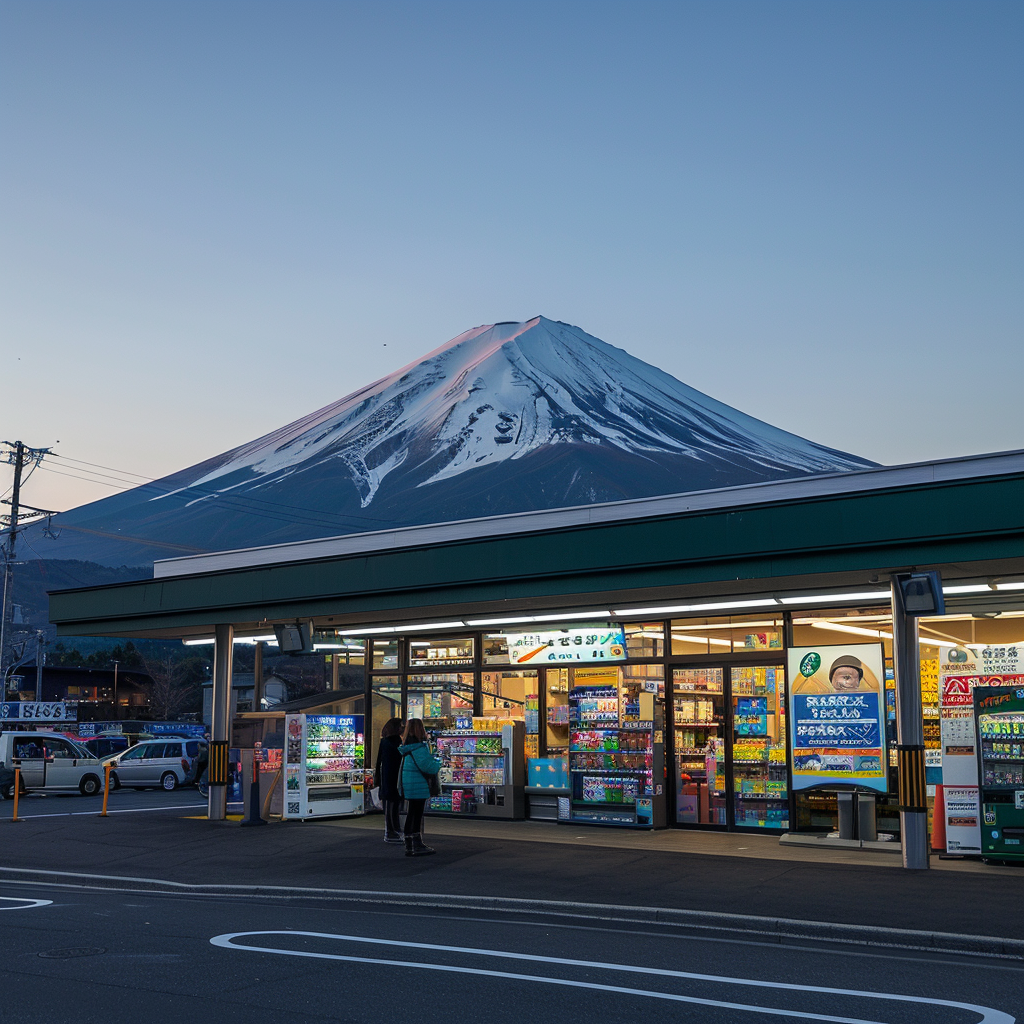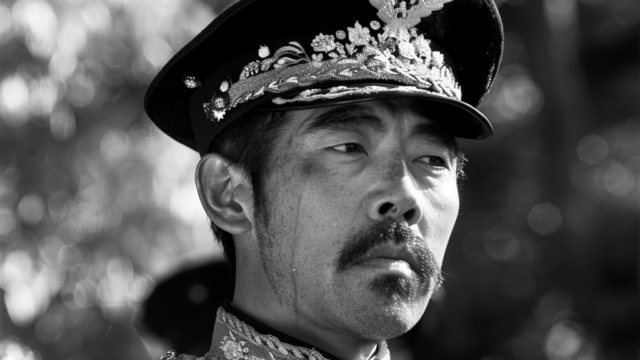
Japan’s “Instagrammable” Mt. Fuji Spot to be Obscured Amid Safety Concerns
A popular photo spot in Yamanashi Prefecture, where tourists can capture Mount Fuji appearing to sit atop a convenience store, will be obscured by a 20-meter-long, 2.5-meter-high black curtain due to complaints from locals about overcrowding, dangerous behavior, and traffic disruptions caused by the influx of visitors. (47語)
日本語訳
「富士山コンビニ写真スポット、安全性の懸念から見えなくなる」
山梨県にある人気の「インスタ映え」スポットで、富士山がコンビニの上に座っているように見える写真が撮れる場所が、まもなく見えなくなる。地元当局は、完璧な1枚を求めて殺到する観光客による混雑や危険な行動、交通渋滞に関する住民からの苦情に対処するため、長さ20メートル、高さ2.5メートルの黒いカーテンを設置する計画だ。

単語・熟語チェック
・obscure 不明瞭にする、隠す
・amid ~の最中に
・safety 安全
・concern(s) 懸念、心配
・influx 殺到、流入
・overcrowding 混雑、過密
・disruption 混乱、中断
・authorities 当局
単語解説
・obscure
⇒隠す、不明瞭にする、曖昧にするという意味の動詞。名詞形だと「無名の」「難解な」などの意味になります。語源はラテン語の obscurus で、「暗い」「不明瞭な」という意味に由来します。ob は「覆う」という接頭辞、scurus は「暗い」という意味の語幹です。
・amid
⇒「~の最中に」「~に囲まれて」という意味の前置詞。語源は古英語の on middan で、「真ん中に」という意味。現代英語の middle と同じ語源を持ちます。amid the chaos(混沌の中で)、amid concerns(懸念の中で)のように使います。among との違いは、amid は漠然とした状況を表すのに対し、among は具体的な物事の中という意味合いが強いことです。
・influx
⇒流入、殺到という意味の名詞。動詞の influx は「流入する」という意味。語源はラテン語の influxus で、「流れ込む」という意味。接頭辞の in は「中へ」、fluxus は「流れる」という意味に由来します。an influx of tourists(観光客の殺到)のように使います。
・disrupt
⇒混乱させる、中断させるという意味の動詞。名詞形は disruption。語源はラテン語の disrumpere で、「バラバラに壊す」という意味。接頭辞の dis は「離れて」「別々に」、rumpere は「壊す」「破る」という意味に由来します。交通機関の運行を止めることを transport disruption と言ったりします。
原ちゃんチェック
観光地の「インスタ映え」を狙った行動が問題視されるケースが増えていますね。写真を撮るために無理な体勢をとったり、立ち入り禁止区域に侵入したりするなど、危険な行為も見受けられます。
SNSで拡散される画像の影響力は大きいだけに、行き過ぎた行動には注意が必要だと思います。観光スポット側も対策に頭を悩ませているようですが、景観を損ねずに安全性を確保するのは難しい課題のようです。
富士山は日本を代表する観光資源ですから、景観を守りつつ持続可能な観光のあり方を模索していく必要がありそうです。旅行者のマナー向上はもちろん、地域と一体となった受け入れ態勢の整備も重要になるでしょう。
観光は地域活性化の切り札になる一方で、オーバーツーリズムなどの弊害も指摘されるようになりました。「インスタ映え」を追求するあまり、観光地の本来の魅力が損なわれるようなことがあってはならないですね。
関連URL
原田英語深堀りチェック
【富士山に関する英単語&英語表現20】
1. Mount Fuji [富士山] – The highest mountain in Japan, known for its iconic, nearly perfectly symmetrical volcanic cone. (日本で最も高い山で、そのシンボリックでほぼ完璧に対称な火山の円錐形で知られている。)
2. Summit [山頂] – The highest point of Mount Fuji, reaching an elevation of 3,776 meters (12,389 feet). (富士山の最高点で、標高3,776メートル(12,389フィート)に達する。)
3. Crater [火口] – The circular depression at the top of Mount Fuji, formed by volcanic activity. (火山活動によって形成された、富士山の頂上にある円形の窪地。)
4. Volcanic ash [火山灰] – Fine particles ejected from Mount Fuji during past eruptions, which can be found in the surrounding areas. (過去の噴火の際に富士山から噴出した微細な粒子で、周辺地域で見つけることができる。)
5. Torii gate [鳥居] – A traditional Japanese gate found at the entrance of the Fujisan Hongu Sengen Taisha shrine, which is associated with the worship of Mount Fuji. (富士山の信仰に関連する富士山本宮浅間大社の入り口にある、日本の伝統的な門。)
6. Pilgrimage [巡礼] – The act of climbing Mount Fuji for spiritual or religious reasons, particularly during the summer months. (特に夏の間に、精神的または宗教的な理由で富士山に登ること。)
7. Hiking trails [ハイキングトレイル] – Paths on Mount Fuji that lead to the summit, varying in difficulty and length. (富士山の頂上に通じる道で、難易度と長さが異なる。)
8. Ascending [登る] – The act of climbing up Mount Fuji, often requiring physical endurance and preparation. (富士山を登ること。多くの場合、体力と準備が必要とされる。)
9. Descending [下る] – The process of coming down from the summit of Mount Fuji, which can be challenging due to steep slopes and loose volcanic rock. (富士山の頂上から下りること。急な斜面と緩んだ火山岩のために困難な場合がある。)
10. Altitude sickness [高山病] – A condition caused by the lower oxygen levels at high elevations, which can affect climbers on Mount Fuji. (高地での酸素レベルの低下によって引き起こされる状態で、富士山の登山者に影響を与える可能性がある。)
11. Sunrise [日の出] – The iconic view of the sun rising from the summit of Mount Fuji, often a goal for climbers who attempt to reach the top before dawn. (富士山の頂上から昇る太陽の象徴的な光景。夜明け前に頂上に到達しようとする登山者の目標となることが多い。)
12. Sea of clouds [雲海] – A phenomenon where clouds form below the summit of Mount Fuji, creating a stunning, otherworldly view. (富士山の頂上の下に雲が形成され、壮大で別世界のような景色を作り出す現象。)
13. Subashiri Trail [須走ルート] – One of the four main trails leading to the summit of Mount Fuji, known for its lush forests and stunning views. (富士山の頂上に通じる4つの主要ルートの1つ。豊かな森林と壮大な景色で知られている。)
14. Yoshida Trail [吉田ルート] – The most popular and well-maintained trail on Mount Fuji, starting from Yamanashi Prefecture. (富士山で最も人気があり、整備された登山道。山梨県から始まる。)
15. Gotemba Trail [御殿場ルート] – A trail on the southeastern side of Mount Fuji, known for its challenging terrain and stunning views of the surrounding area. (富士山の南東側にある登山道で、険しい地形と周辺の素晴らしい景色で知られている。)
16. Fujinomiya Trail [富士宮ルート] – The shortest and steepest trail to the summit of Mount Fuji, starting from Shizuoka Prefecture. (静岡県から始まる、富士山の頂上へ至る最短かつ最も急な登山道。)
17. Five Lakes [富士五湖] – A group of five scenic lakes located at the northern base of Mount Fuji: Lake Kawaguchi, Lake Yamanaka, Lake Sai, Lake Shoji, and Lake Motosu. (富士山の北麓にある5つの景勝地の湖の総称。河口湖、山中湖、西湖、精進湖、本栖湖。)
18. Volcano [火山] – Mount Fuji is classified as an active volcano, although it has not erupted since 1707. (富士山は活火山に分類されているが、1707年以来噴火していない。)
19. UNESCO World Heritage Site [ユネスコ世界遺産] – Mount Fuji was registered as a UNESCO World Heritage Site in 2013, recognized for its cultural significance. (富士山は、その文化的重要性が認められ、2013年にユネスコ世界遺産に登録された。)
20. Symbol of Japan [日本の象徴] – Mount Fuji is widely considered a national symbol of Japan, frequently depicted in art, literature, and popular culture. (富士山は広く日本の国家的シンボルと見なされ、美術、文学、ポップカルチャーでもしばしば描かれる。)






